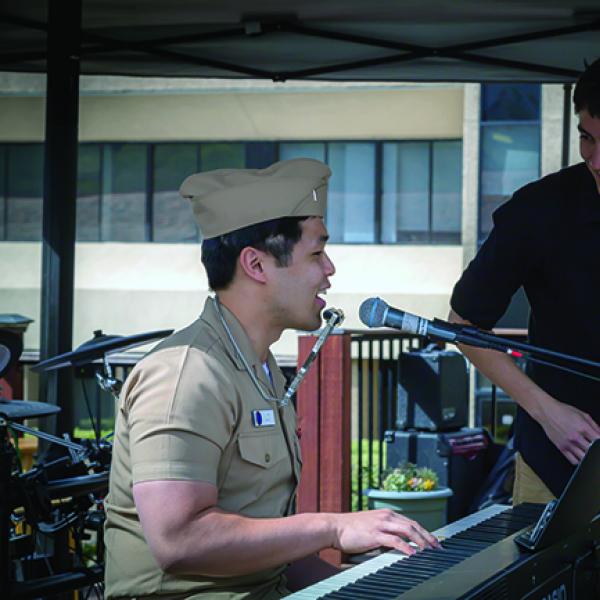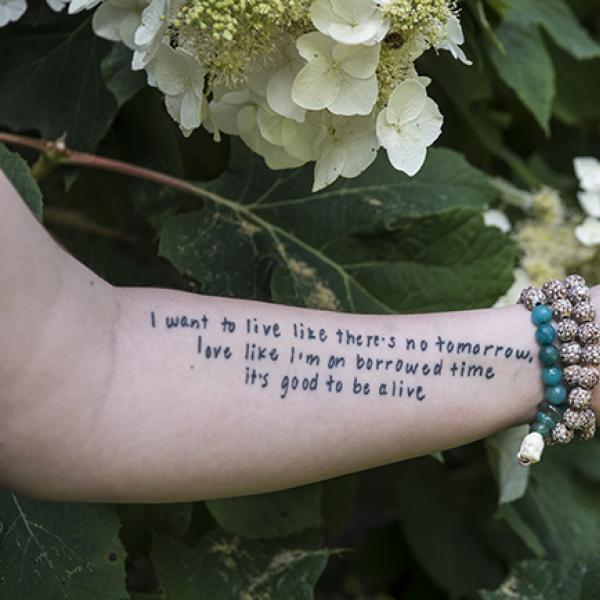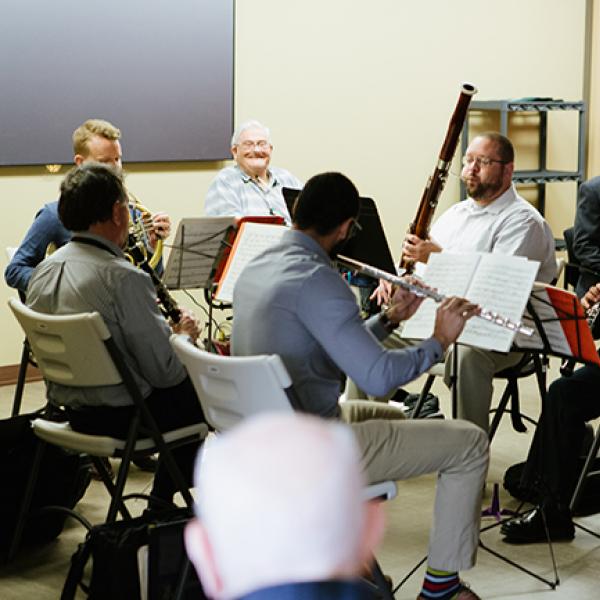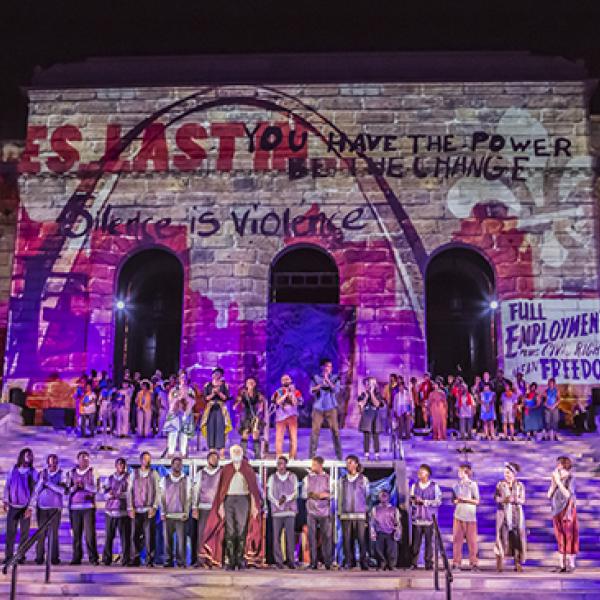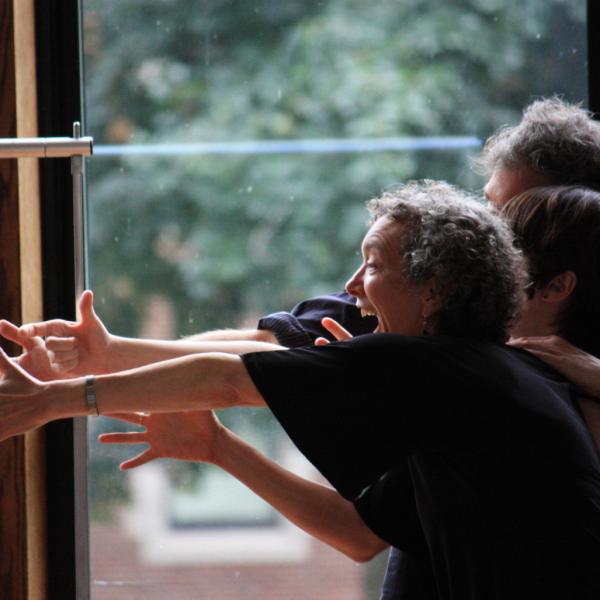Advancing Recovery
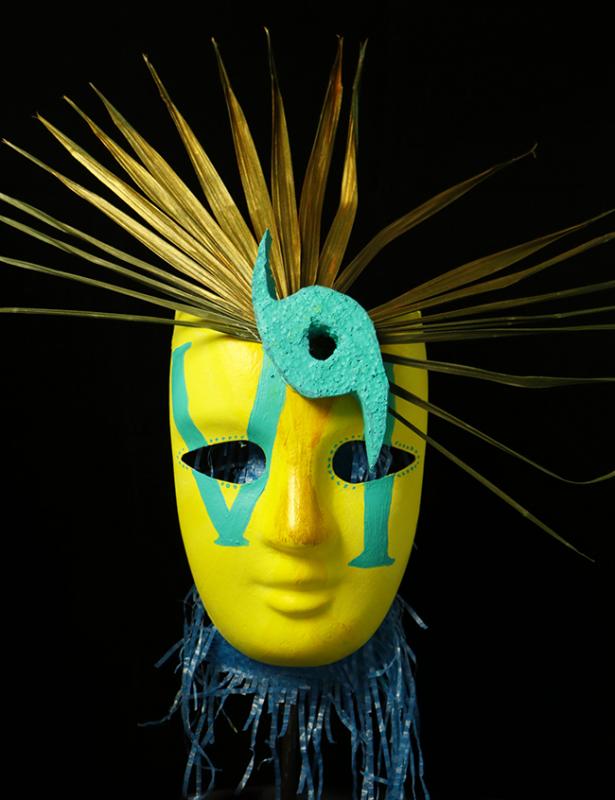
Andi Mathis, the state and regional specialist at the National Endowment for the Arts, found a post-apocalyptic landscape when she arrived in the U.S. Virgin Islands after Hurricanes Maria and Irma decimated the region in 2017. There were heaps of scrap metal by the side of the road. Many buildings had their roofs blown off, leaving them open to the sky. Normally bustling public areas were eerily empty, and people seemed haggard and battle-worn. “It was heartbreaking, just heartbreaking,” she said.
Mathis had traveled to the U.S. Virgin Islands, as well as Puerto Rico, to facilitate the National Endowment for the Arts’ relief efforts following the devastating storms. It was part of the Arts Endowment’s long history of responding to natural and man-made disasters, and using the arts to promote healing following community trauma. After the 1995 Oklahoma City bombing, for example, the National Endowment for the Arts led design charrettes to create a memorial honoring the 168 men, women, and children who died in the attack. Following Hurricanes Katrina, Rita, and Wilma in 2005, the Arts Endowment invested $700,000 in support for the Gulf Coast’s emotional and physical recovery. And in 2017, the agency awarded emergency funding to the state arts agencies in Florida and Texas to re-grant to artists and organizations affected by Hurricanes Harvey and Irma. The NEA also sits on the steering committees of coalitions that help arts agencies both prepare for and respond to emergencies, including the National Coalition for Arts Preparedness and Emergency Response (NCAPER) and the Heritage Emergency National Task Force (HENTF).
After Hurricane Maria, the National Endowment for the Arts carried out a multipronged relief effort, awarding emergency funding for re-granting to the affected state arts agencies—the Instituto de Cultura Puertorriqueña (ICP) and the Virgin Islands Council on the Arts— and as a member agency in the federal Natural and Cultural Resources Recovery Support Function (NCRRSF), working in coordination with other federal agencies, such as the Federal Emergency Management Agency (FEMA) and the Department of the Interior to help address recovery for the arts and cultural sector. Mathis, as the NEA’s representative to the NCRRSF, has deployed multiple times to the U.S. Virgin Islands and Puerto Rico, while NEA Historic Preservation Officer Brian Lusher has deployed four times to Puerto Rico to date. Through these multiple approaches, the Arts Endowment has been able to provide financial support, technical and policy assistance, and leadership when asked and needed.
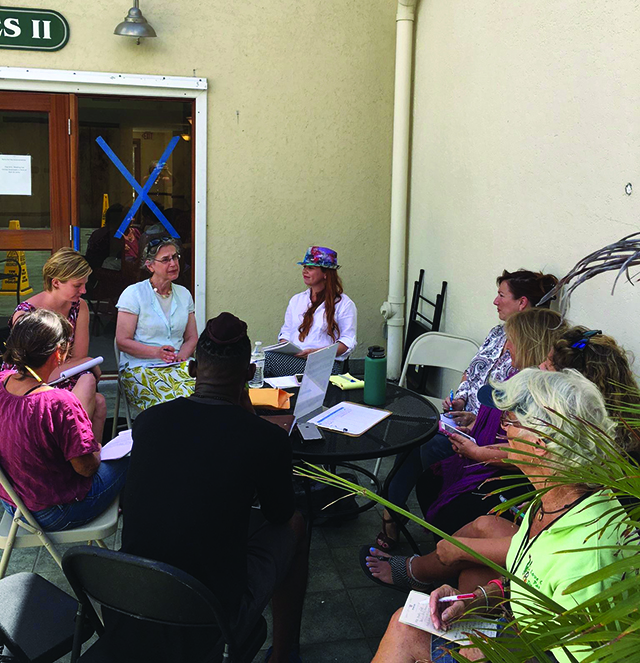
|
“[The arts] can help in communal healing, can help with economic recovery, and can help with community development recovery,” said Mathis. “A lot of people don’t realize how arts and culture can advance recovery in so many different areas.”
“The National Endowment for the Arts has played a key role in ensuring that the arts and culture is represented in the Economic and Disaster Recovery Plan for Puerto Rico after the impact of the hurricanes,” said Carlos R. Ruiz Cortés, executive director of the ICP. “The support has helped artists and the general population.”
During Lusher’s deployments, he served as the cultural resources coordinator for FEMA’s Natural and Cultural Resources Sector (NCR RSF) in Puerto Rico, and aided the recovery of historic properties and districts, like San German, Aguirre, and Old San Juan.
NCR RSF assessed damage and drafted plans for the long-term repair of the natural and cultural resources of Puerto Rico, focusing on national forests, coral reefs, parks, municipal town squares, historic buildings and districts, archaeological sites, ruins, and museum collections.
“Cultural places represent the heart of a community,” said Lusher. “The Plaza Colón in Old San Juan, for instance, is a place where Puerto Ricans have gathered for over a century.”
When Lusher saw the extent of the damage, he “felt the desperation of the place because so many people were affected by the storms.” Nonetheless, he was motivated and made hopeful by the many stories of strength and perseverance he heard along the way.
As part of his deployments, he worked with the Galería Nacional, a museum inside the Saint Aquinas monastery in Old San Juan that houses the largest and most important collection of Puerto Rican artworks. The Galería was suffering from pervasive black mold and a destroyed HVAC system. FEMA removed the damaged HVAC condenser unit and is currently planning a comprehensive repair of the gallery’s damages.
By repairing the properties, Lusher and his team in turn helped to preserve the character, history, and special culture and social fabric of Puerto Rico. “It’s important to focus on preserving areas of Puerto Rico’s cultural heritage because they are a physical reminder of the island’s values and history,” said Lusher.
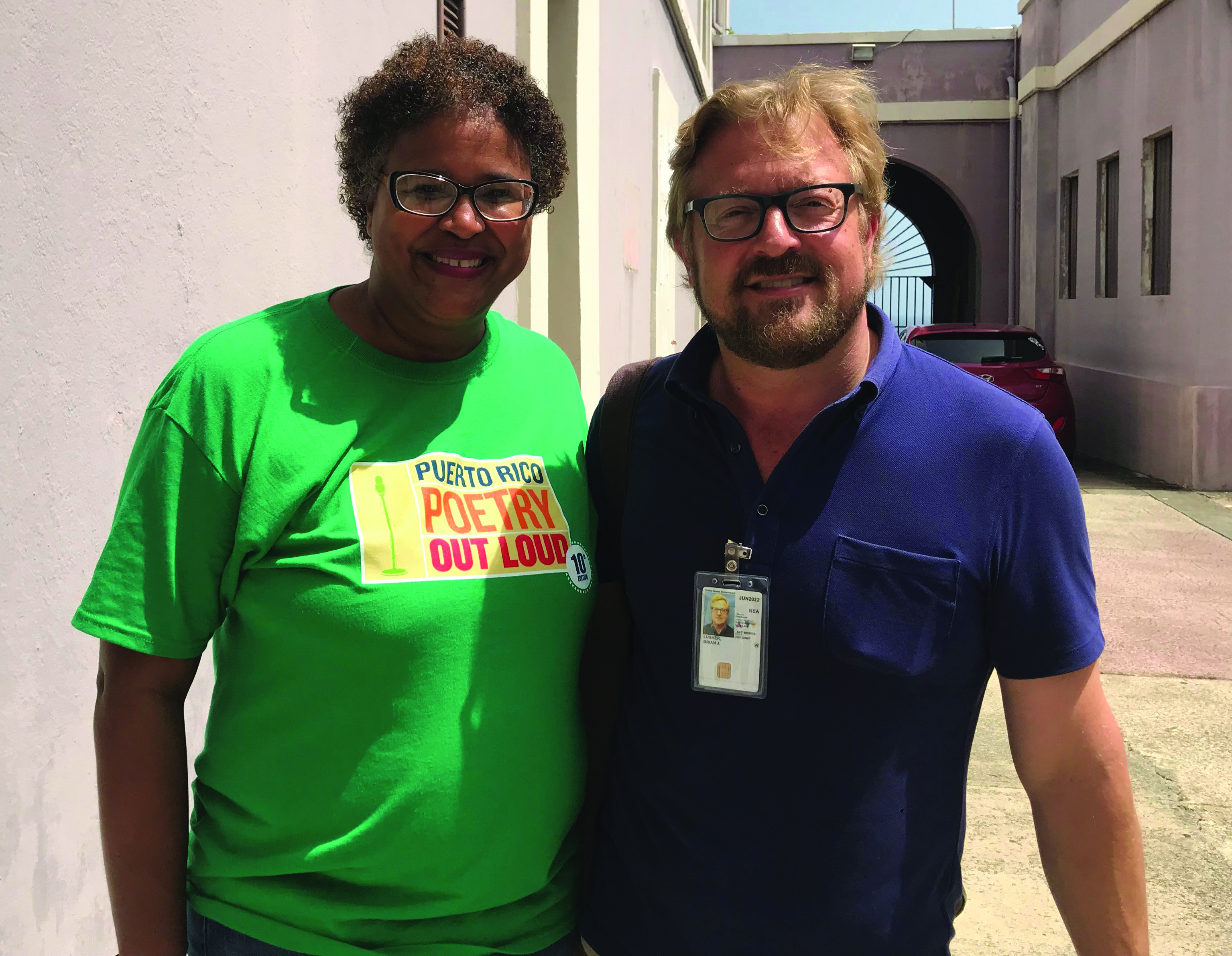
|
He emphasized their economic value, as well. “San Juan is not only a historic district, it’s an economic hub where cruise ships restock supplies and tourists explore the community. It’s an example of a historically significant place that is also an important part of the economy.”
Kristin Fontenot, the director of FEMA’s office of environmental planning/historic preservation, noted that addressing the island’s current needs goes hand-in-hand with securing its future. With the combined expertise and resources from so many agencies, including the NEA, Fontenot, said, “I am confident we are thinking strategically about how to benefit artists and arts organizations in ways that will long outlast their individual efforts in the Commonwealth [of Puerto Rico].”
While the arts have helped the large-scale physical, economic, and cultural healing, they have also helped individuals in both Puerto Rico and the Virgin Islands continue to process their collective trauma. “The arts are so important to both of those cultures,” said Mathis. “I think it helped them retain a sense of normalcy when they were able to participate in the arts—to see beauty and experience art and make art.”
On her first visit to the Virgin Islands, Mathis met with a group of local artists and arts administrators and talked about the NEA’s Creative Forces program, which brings creative arts therapy to service members and veterans with post-traumatic stress disorder and traumatic brain injuries. She said that Creative Forces’ mask-making project, which invites patients to create masks with expressions of their feelings, memories, and identities, resonated with the group in the Virgin Islands, and they developed a mask-making program of their own in St. John.
“They tied it in with the whole notion of Carnival and shedding the past and moving into the future,” Mathis explained. “There is a big mask-making tradition in the Virgin Islands and the Caribbean. They rolled all that in together and had workshops all over the islands for schoolchildren, seniors, and anybody who wanted to come and make masks.”
Even though the state art agencies were just as ravaged as their grantees, Mathis found they worked incredibly hard to support their constituents with disaster funds from the NEA. “The [Instituto de Cultura Puertorriqueña] developed a special program called Cultura Rodante, Culture on Wheels, where they brought arts programming into the barrios, into the communities and neighborhoods, into senior centers,” Mathis explained. “It was great because it brought arts experiences to people who couldn’t go out anywhere because there was no power. So there were no restaurants, there were no lights, no movie theaters, and no live theater. Nothing was open, things were growing mold, and nothing had power. And it provided employment for artists whose other jobs had dried up because there were no performance spaces for them to work in.”
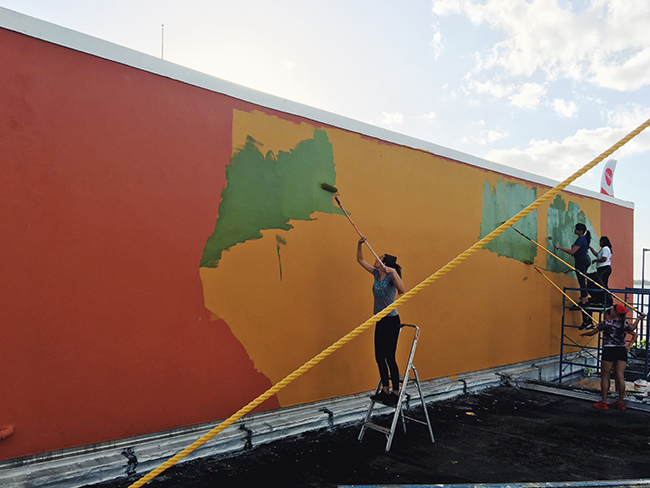
|
In another example of interagency collaboration, representatives from the Department of Health and Human Services reached out to the Arts Endowment for advice on the cultural aspect of a behavioral health campaign in Puerto Rico to combat post-hurricane increases in alcoholism, drug abuse, depression, and suicide. Mathis connected the Instituto de Cultura Puertorriqueña with the project, and with NEA support, the ICP employed the female art collective Moriviví to develop a mural with the residents of Cataño, a community that has suffered from high substance abuse and suicide rates since the hurricane.
Chachi González, an artist with Moriviví, explained that the mural is being done in collaboration with the local high school. To decide on a subject for the mural, the collective held a series of workshops, where students were asked to brainstorm words that best represented their community and experiences in Cataño. The students were also asked, “How can I be a part of the change that I want to see?”
The mural’s creation is already underway, and depicts the Cataño that was—a beautiful area filled with mangroves. A girl, representing the city’s youth, sits amongst the mangroves sowing the seeds for the future. To her left are three women hanging wet newspapers with relevant headlines on a clothesline under a bright sun, symbolizing the community coming together to mourn openly in the light, heal, and work towards a better tomorrow.
González hopes the mural, which will be painted by the students themselves, will continue the conversations that led to its creation. “The dialogue that leads to generating the image is fundamental to the healing process. It is in this discussion that we make sense of our experiences,” she said. “Healing is about not denying the situations we’re in and forgetting them, but turning them into stories of what we are able to do and what we can overcome.”
Paloma Losada was an intern in the NEA Office of Public Affairs in spring 2019.


